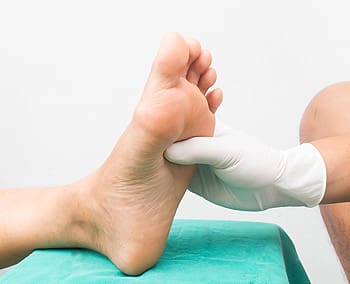 Podiatrists treat a variety of dermatological conditions that affect the feet and ankles such as athletes foot, warts, nummular dermatitis, psoriasis, and eczema.
Podiatrists treat a variety of dermatological conditions that affect the feet and ankles such as athletes foot, warts, nummular dermatitis, psoriasis, and eczema.
Athletes Foot
Athlete’s foot, also known as tinea pedis, is a fungal infection of the skin on the feet and especially between the toes. It presents as a red, scaly and very itchy rash which sometimes stings, burns, or even blisters. This highly contagious infection can be spread by direct contact with someone who has it, and also in warm, moist environments such as locker rooms, public showers and swimming areas where the fungal organism thrives. Athlete’s foot can also be spread indirectly by sharing personal items such as socks, towels, shoes or toenail clippers with someone who is infected.
Your podiatrist will examine your feet and may even sample the skin to rule out other types of infections. They may treat athlete’s foot with prescription anti-fungal medications, creams, sprays, powders or ointments.
Warts
Plantar warts are a common condition that podiatrists treat. They are caused by the human papillomavirus (HPV). Plantar warts grow on the bottom of the feet. They are flat patches of grainy skin that may have a visible black dot in the center, which is actually dried blood in a minuscule blood vessel. Because they grow on the sole of the feet, they can be quite painful because as you walk, you put pressure on the wart. Like athlete’s foot, plantar warts can be spread through direct contact with someone who has the viral infection, or in public areas that are damp and warm.
Plantar warts are hearty and difficult to treat effectively and permanently at home. Your podiatrist may use a variety of treatment methods to remove your plantar wart(s) including laser therapy, freezing, burning, salicylic acid, and more.
Nummular Dermatitis
Nummular dermatitis is a form of dermatitis. Because it presents as round/oval, or “coin-like” lesions or blisters, it gets its name from the Latin word for coin: nummus. Some believe this chronic, itchy rash may be stress-related, or due to dry skin, dry air or certain oral medications, skin infections or injuries, humidity and heat, or excessive alcohol consumption. If not treated properly, this bothersome condition may last for months or even years.
Your podiatrist may treat nummular dermatitis and its symptoms with topical or oral antibiotics, antihistamines, ointments, or steroids.
Psoriasis
There are different forms of psoriasis, with the one that affects most people being plaque psoriasis. This is a chronic inflammatory skin condition that produces a scaly, red, and sometimes painful rash. Psoriasis may occur throughout the body. When it occurs on the feet, it is referred to as plantar psoriasis. It is believed to be linked to other diseases such as arthritis, Crohn’s disease, and autoimmune diseases. Psoriasis may be mistaken for athlete’s foot or fungal infections.
Topical and oral medications along with UV light therapy, salicylic acid solutions and injections may be used by your podiatrist to stop or slow down the growth of skin cells responsible for forming plaques on the skin.
Eczema
Another type of rash that may form on the feet is eczema. When it appears on the feet, it too may be mistaken for athlete’s foot because it produces red, itchy, dry, blistering, cracking or crusting skin. However, it does not usually present between the toes like Athlete’s foot can. Severe emotional or physical stress, seasonal allergies, or being exposed to nickel or chromium may be responsible for eczema forming.
Your podiatrist may use corticosteroid, anti-itch, or immune-suppressant creams and lotions, antihistamines, or suggest dietary changes, and possibly may even drain blisters that are large and painful.
If you are suffering from one of these dermatological conditions on your feet or ankles, make an appointment with your podiatrist who will diagnose your condition and begin effective treatment right away.
